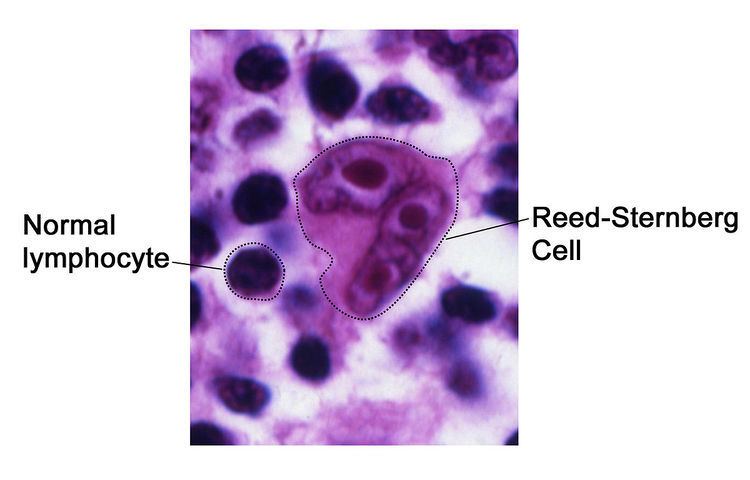 | ||
Reed–Sternberg cells (also known as lacunar histiocytes for certain types) are different giant cells found with light microscopy in biopsies from individuals with Hodgkin's lymphoma (a.k.a. Hodgkin's disease, a type of lymphoma). They are usually derived from B lymphocytes, classically considered crippled germinal center B cells, meaning they have not undergone hypermutation to express their antibody. Seen against a sea of B cells, they give the tissue a moth-eaten appearance.
Contents
Classification of Hodgkin's is based on the reactive cell mixture. Immunomarkers are used (e.g., CD15 and CD30).
Reed–Sternberg cells are large 30–50 microns and are either multinucleated or have a bilobed nucleus with prominent eosinophilic inclusion-like nucleoli (thus resembling an "owl's eye" appearance). Reed–Sternberg cells are CD30 and CD15 positive, usually negative for CD20 and CD45. The presence of these cells is necessary in the diagnosis of Hodgkin's lymphoma – the absence of Reed–Sternberg cells has very high negative predictive value. They can also be found in reactive lymphadenopathy (such as infectious mononucleosis immunoblasts which are RS like in appearance, carbamazepine associated lymphadenopathy) and very rarely in other types of non-Hodgkin lymphomas. Anaplastic large cell lymphoma may show RS like cells also.
History
They are named after Dorothy Reed Mendenhall and Carl Sternberg, who provided the first definitive microscopic descriptions of Hodgkin's disease.
Hodgkin's lymphoma
A special type of Reed–Sternberg cells (RSCs) is the lacunar histiocyte, whose cytoplasm retracts when fixed in formalin, so the nuclei give the appearance of cells that lie with empty spaces (called lacunae) between them. These are characteristic of the nodular sclerosis subtype of Hodgkin's lymphoma.
Mummified RSCs (compact nucleus, basophilic cytoplasm, no nucleolus) are also associated with classical Hodgkin's lymphoma while popcorn cells (small cell with hyper-lobulated nucleus and small nucleoli) are lymphohistiocytic (L-H) variant of Reed Sternberg cells and are associated with nodular lymphocyte predominant Hodgkin's lymphoma (NLPHL).
RSCs and one RSC cell line (L1236 cells) but not other RSC cell lines express very high levels of ALOX15 (i.e., 15-lipoxyenase-1), an enzyme that metabolizes arachidonic acid and various other polyunsaturated fatty acids to a wide array of bioactive products (see 15-hydroxyicosatetraenoic acid). This is unusual in that lymphocytes typically express little or no ALOX15. It is suggested that ALOX15, perhaps operating through is products such as the eoxins, contributes to the development and/or morphology of Hodgkin's lymphoma.
